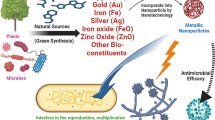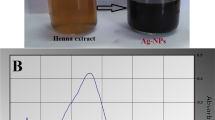Abstract
The use of antibiotics in addition to drug resistance can cause harmful side effects. The presence of nanoparticles as novel antibacterial agents and carriers for drug delivery are important for the treatment of diseases. Pseudomonas aeruginosa is an opportunistic pathogen and resistance to antibiotics that infects damaged tissues and also people with a weak immune system. In this study, zerovalent copper (Cu0) and iron (Fe0) nanoparticles with the average size of 25 nm and less than 50 nm, respectively, were synthesized by chemical reduction method. Scanning electron microscopy (SEM) has been used to determine the particle size and morphology. The antibacterial effect of these nanoparticles against Pseudomonas aeruginosa was assessed. The minimum inhibitory concentrations (MIC), as well as minimum bactericidal concentration (MBC), were determined using colony count and measurement of optical density methods. The results of treatment Pseudomonas aeruginosa with zerovalent iron and copper nanoparticles showed that the rate of growth was reduced in a dose-dependent manner and these nanoparticles showed that bactericidal effect on Pseudomonas aeruginosa. The effect of zerovalent iron and copper nanoparticles on heat shock gene expression dnaK were studied using real-time RT-PCR. Gene expression levels indicated that dnaK expression was reduced 10- and 7-fold in treatment with Fe0 and Cu0, respectively. Since the nanoparticles inhibited the bacterial growth, the expression level has decreased compared with control.









Similar content being viewed by others
References
Baker-Austin, C., et al. (2006). Co-selection of antibiotic and metal resistance. Trends Microbiol, 14, 176–182.
Hajipour, M. J., Fromm, K. M., Ashkarran, A. A., Jimenez de Aberasturi, D., Ruiz de Larramendi, I., Rojo, T., Serpooshan, V., Parak, W. J., & Mahmoudi, M. (2012). Antibacterial properties of nanoparticles. Trends Biotechnol, 30(10), 499–511.
Baltch A, Smith RP (1994) Pseudomonas aeruginosa: Infections and treatment., Marcel Dekker, New York, NY
Cornelis P (2008) Pseudomonas: genomics and molecular biology. Horizon Scientific Press
Levy, S. B. (1991). Antibiotic availability and use: consequences to man and his envronment. J Clin Epidemiol, 45, 83–87.
Tong, G., Yulong, M., Peng, G., & Zirong, X. (2005). Antibacterial effects of the cu (II)-exchanged montmorillonite on Escherichia coli K88 and Salmonella choleraesuis. Vet Microbiol, 105(2), 113–122.
Hu, C. H., & Xia, M. S. (2006). Adsorption and antibacterial effect of copper-exchanged montmorillonite on Escherichia coli K 88. Appl Clay Sci, 31(3), 180–184.
Mamunya, Y. P., Zois, H., Apekis, L., & Lebedev, E. V. (2004). Influence of pressure on the electrical conductivity of metal powders used as fillers in polymer composites. Powder Technol, 140(1), 49–55.
Michels HT, Wilks SA, Noyce JO, Keevil CW (2005) Copper alloys for human infectious disease control. Presented at Materials Science and Technology Conference, September 25–28, Pittsburgh, PA Copper for the 21st Century Symposium
Gorby, Y. A., Yanina, S., McLean, J. S., Rosso, K. M., Moyles, D., Dohnalkova, A., & Culley, D. E. (2006). Electrically conductive bacterial nanowires produced by Shewanella oneidensis strain MR-1 and other microorganisms. Proc Natl Acad Sci, 103(30), 11358–11363.
Kirchner, C., Liedl, T., Kudera, S., Pellegrino, T., Muñoz Javier, A., Gaub, H. E., & Parak, W. J. (2005). Cytotoxicity of colloidal CdSe and CdSe/ZnS nanoparticles. Nano Lett, 5(2), 331–338.
Young, J. C., Barral, J. M., & Hartl, F. U. (2003). More than folding: localized functions of cytosolic chaperones. Trends Biochem Sci, 28(10), 541–547.
Ritossa, F. (1962). A new puffing pattern induced by temperature shock and DNP in drosophila. Cell Mol Life Sci, 18(12), 571–573.
Ritossa F(1996) Discovery of the heat shock response. Cell stress & chaperones 1(297
Livak, K. J., & Schmittgen, T. D. (2001). Analysis of relative gene expression data using real-time quantitative PCR and the 2− ΔΔCT method. Methods, 25(4), 402–408.
Sayılkan, F., Asiltürk, M., Kiraz, N., Burunkaya, E., Arpaç, E., & Sayılkan, H. (2009). Photocatalytic antibacterial performance of Sn 4+−doped TiO 2 thin films on glass substrate. J Hazard Mater, 162(2), 1309–1316.
May, T. B., Shinabarger, D., Maharaj, R. O. M. I. L. A., Kato, J., Chu, L., DeVault, J. D., & Rothmel, R. K. (1991). Alginate synthesis by Pseudomonas aeruginosa: A key pathogenic factor in chronic pulmonary infections of cystic fibrosis patients. Clin Microbiol Rev, 4(2), 191–206.
Ghorbani, R., Moradian, F., & Biparva, P. (2018). Assessment of different antibacterial effects of Fe and cu nanoparticles on Xanthomonas campestris growth and expression of its pathogenic gene hrpE. J Agric Sci Technol, 20, 1059–1070.
Morones, J. R., Elechiguerra, J. L., Camacho, A., Holt, K., Kouri, J. B., Ramírez, J. T., & Yacaman, M. J. (2005). The bactericidal effect of silver nanoparticles. Nanotechnology, 16(10), 2346.
Ruparelia, J. P., Chatterjee, A. K., Duttagupta, S. P., & Mukherji, S. (2008). Strain specificity in antimicrobial activity of silver and copper nanoparticles. Acta Biomater, 4(3), 707–716.
Usman, M. S., El Zowalaty, M. E., Shameli, K., Zainuddin, N., Salama, M., & Ibrahim, N. A. (2013). Synthesis, characterization, and antimicrobial properties of copper nanoparticles. Int J Nanomedicine, 8, 4467.
Farag, S. S. S., & Hebeish, A. (2015). Multifunctionalized cotton fabric using cu nanoparticles. Int J Adv Res, 3(6), 125–136.
Lee, H. J., Yeo, S. Y., & Jeong, S. H. (2003). Antibacterial effect of nanosized silver colloidal solution on textile fabrics. J Mater Sci, 38(10), 2199–2204.
Cioffi, N., Torsi, L., Ditaranto, N., Tantillo, G., Ghibelli, L., Sabbatini, L., & Traversa, E. (2005). Copper nanoparticle/polymer composites with antifungal and bacteriostatic properties. Chem Mater, 17(21), 5255–5262.
Raffi, M., Hussain, F., Bhatti, T. M., Akhter, J. I., Hameed, A., & Hasan, M. M. (2008). Antibacterial characterization of silver nanoparticles against E. coli ATCC-15224. J Mater Sci Technol, 24(2), 192–196.
Barnard, A. S. (2006). Nanohazards: knowledge is our first defence. Nat Mater, 5(4), 245–248.
Barzan, E., Mehrabian, S., & Irian, S. (2014). Antimicrobial and genotoxicity effects of zero-valent iron nanoparticles. Jundishapur J Microbiol, 7(5), 1–5.
Mahapatra, O., Bhagat, M., Gopalakrishnan, C., & Arunachalam, K. D. (2008). Ultrafine dispersed CuO nanoparticles and their antibacterial activity. J Exp Nanosci, 3(3), 185–193.
Selvarani, M., & Prema, P. (2013). Evaluation of antibacterial efficacy of chemically synthesized copper and zerovalent iron nanoparticles. Asian J Pharm Clin Res, 6(3), 223–227.
Raffi, M., Mehrwan, S., Bhatti, T. M., Akhter, J. I., Hameed, A., Yawar, W., & ul Hasan, M. M. (2010). Investigations into the antibacterial behavior of copper nanoparticles against Escherichia coli. Ann Microbiol, 60(1), 75–80.
Rai, M., Yadav, A., & Gade, A. (2009). Silver nanoparticles as a new generation of antimicrobials. Biotechnol Adv, 27(1), 76–83.
Yagi, S., Nakanishi, H., Matsubara, E., Matsubara, S., Ichitsubo, T., Hosoya, K., & Matsuba, Y. (2008). Formation of cu nanoparticles by electroless deposition using aqueous CuO suspension. J Electrochem Soc, 155(6), 474–479.
Segal, G., & Ron, E. Z. (1998). Regulation of heat-shock response in bacteria. Ann N Y Acad Sci, 851(1), 147–151.
Tavaria, M., Gabriele, T., Kola, I., & Anderson, R. L. (1996). A hitchhiker’s guide to the human Hsp70 family. Cell Stress Chaperones, 1(1), 23.
Morano, K. A. (2007). New tricks for an old dog. Ann N Y Acad Sci, 1113(1), 1–14.
Mashaghi, A., Bezrukavnikov, S., Minde, D. P., Wentink, A. S., Kityk, R., Zachmann-Brand, B., & Tans, S. J. (2016). Alternative modes of client binding enable functional plasticity of Hsp70. Nature, 539(7629), 448–451.
Xiao, Y., Lu, Y., Heu, S., & Hutcheson, S. W. (1992). Organization and environmental regulation of the Pseudomonas syringae pv. syringae 61 hrp cluster. J Bacteriol, 174(6), 1734–1741.
Acknowledgments
This original research was performed in Sari Agricultural Sciences and Natural Resources University, Department of Basic Sciences, and Cell and Molecular lab. We are thankful for providing facilities and assistance.
Funding
None
Author information
Authors and Affiliations
Corresponding author
Ethics declarations
Conflict of Interest
None
Research Involving Humans and Animals Statement
None
Informed Consent
None
Additional information
Publisher’s Note
Springer Nature remains neutral with regard to jurisdictional claims in published maps and institutional affiliations.
Rights and permissions
About this article
Cite this article
Ghorbani, R., Biparva, P. & Moradian, F. Assessment of Antibacterial Activity and the Effect of Copper and Iron Zerovalent Nanoparticles on Gene Expression DnaK in Pseudomonas aeruginosa. BioNanoSci. 10, 204–211 (2020). https://doi.org/10.1007/s12668-019-00692-2
Published:
Issue Date:
DOI: https://doi.org/10.1007/s12668-019-00692-2




